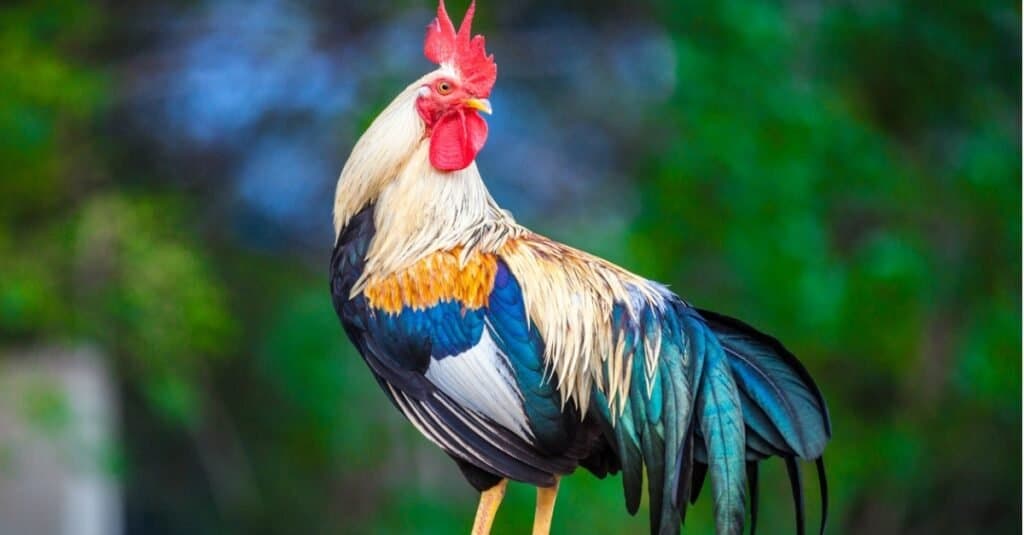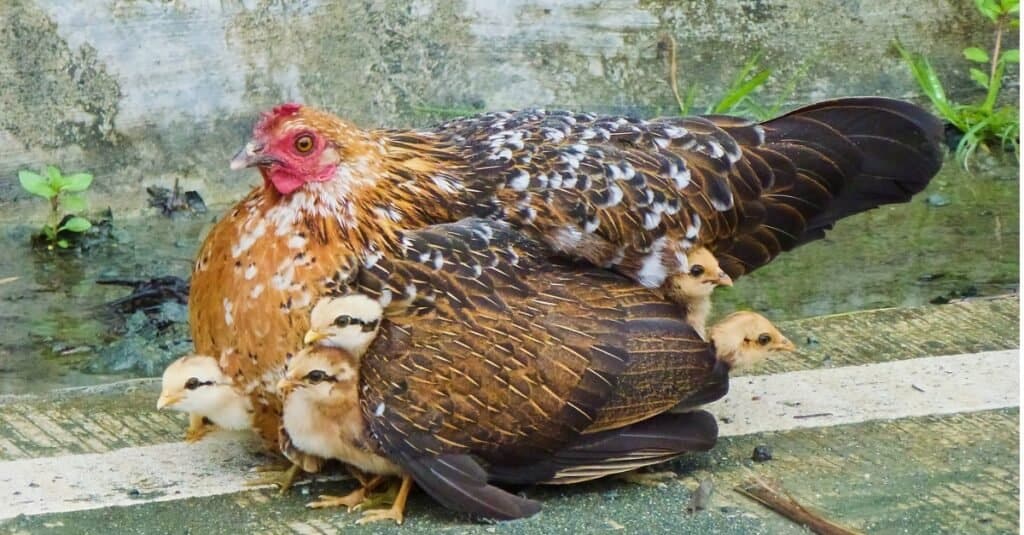Chickens are not mammals. They are birds. They have feathers as opposed to hair or fur, and they have wings, even though they don’t fly very well. They lack the teeth that most mammals have, they exclusively lay eggs, and they don’t nurse their chicks with milk.
It is true that a few birds do feed their chicks with crop milk, but chickens do not. Even birds that produce crop milk aren’t considered mammals.
As birds, chickens are much younger than mammals, and the order they belong to, Galliformes, survived that asteroid that plummeted to earth and wiped out the non-avian dinosaurs and arboreal birds 66 million years ago.
The removal of the dinosaurs allowed birds and mammals to develop into the variety of forms that survive today. Indeed, birds were just getting started as a class of animals around the time of this extinction event.

Farm cock. Fighting cock, gamecock village scene
©iStock.com/IsaacRuiz
Why Would People Think Chickens Are Mammals?
People may think of chickens as mammals because they are often found on farms with other livestock such as cows, sheep, pigs, and horses, which are all mammals. People also eat the meat of chickens, which some consider healthier than the meat of cows or pigs.
Unlike mammals, chickens don’t have fur or hair, they have feathers. This and other features set them apart from mammals. Although, birds can sometimes have bristles on their heads and faces, this doesn’t define them as mammals. They are however, warm blooded creatures that breath air, posses vertebrae, and have some other mammal qualities.
Chickens are also kept as pets like dogs and cats. They like to live in groups that are hierarchical and more or less cooperative and looked after by a male rooster. They are devoted parents, like most mammals. What is interesting is that chicks are precocial, which means they are ready to fend for themselves shortly after hatching. Precocial babies are unusual for mammals.
Still, hens take great care of their chicks for their first few weeks of life, the way mammals do. Hens not only don’t produce milk but don’t directly feed their babies like other birds. Instead, she leads them to food and water, and they help themselves.

©iStock.com/Tunatura
Next Up…
- Chicken Teeth: Do Chickens Have Teeth? – Everyone knows that chickens have beaks, but do they have teeth? Click to find out!
- Can Chickens Fly? – Have you ever seen a chicken fly? Can they? Click to learn more!
- Chicken Lifespan: How Long Do Chickens Live? – Ever wonder how long a chicken’s natural lifespan is? The truth may surprise you!
The photo featured at the top of this post is © iStock.com/undefined undefined
FAQs (Frequently Asked Questions)
Are chickens endangered?
Overall, chickens are the opposite of endangered. As a type of livestock, there are billions of chickens in most places around the world, many of them raised in factory farms. However, there are some breeds that can be considered endangered. This is usually because farmers consider them inferior when it comes to their meat or their egg production or because they need too much maintenance to stay healthy. Breeds of chickens that are becoming rare include:
- White sultan
- Silver Phoenix
- Lakenvelder
- Salmon Faverolle
- Buckeye
- Chantecler
- Holland
- Redcap
- Crevecoeur
- White Yokohama
What is a chicken?
This bird is a subspecies of the red junglefowl, Gallus gallus. The chicken’s scientific name is Gallus gallus domesticus. The male red junglefowl looks just like a small, very colorful domesticated rooster, while the junglefowl hen looks more like a grouse. They are native to southeast and south Asia.
What are they good for?
Chickens are grown for their meat, which is high in protein and low in fat. They are also raised for their eggs, as hens can lay lots of eggs without the help of a rooster. Chicken eggs are also delicious and nutrient-rich. Fertilized eggs are used to study embryology. Chicken feathers, including the sickle tails of roosters, have been used for decorating hats and other apparel. Some people use roosters for cockfighting, crowing contests, or religious ceremonies. Chickens are mentioned in the myths and religions of many people.
How many breeds of chickens are there?
There are at least 500 breeds of chicken worldwide, though 53 large breeds are recognized by the American Poultry Association along with some bantam or miniature breeds.
What is a broody hen?
A broody hen is a hen that sits on a nest and basically doesn’t want to move. She won’t even move to eat or drink or bathe and will take offense if someone tries to move her. She shows this by pecking or fluffing up her feathers. Broody hens are fantastic for incubating eggs, even eggs of different species such as guinea fowl or ducks.
When were chickens first domesticated?
Scientists believe that chickens were first domesticated around 8000 years ago, mostly for cockfighting. Then, people discovered that chickens and their eggs were good to eat.
What are the types of chickens?
A chick is a baby chicken, and a biddy is one that just came out of the egg. A cockerel is a male chicken who is less than a year old, while a pullet is a female chicken who is less than a year old. A hen is a grown female chicken, and a rooster or cock is a grown male chicken. A capon is a male chicken who has been neutered.
What are the parts of a chicken?
The chicken is an exceptional-looking animal. No other animal looks quite like it, and most people can tell a chicken from every other type of bird. Here are some parts from head to toes:
- Comb and wattle. The comb is the fleshy part on top of the bird’s head. Combs are larger on the rooster, and they come in several shapes. They are cushion; strawberry; the familiar single; buttercup, which is a sort of double single; V-shaped; rose and pea. Chickens also have wattles beneath their beaks. The wattles, earlobes and the combs together are called caruncles.
- Hackle. Moving down, the hackles are the neck feathers, and they can be quite beautiful and elegant on a rooster.
- Cape. The cape is found at the back of the neck.
- Saddle. The cape moves down to the back and then to the saddle, which are the feathers just before the tail. These feathers, which are soft, are often used to make fishing flies.
- Sickle. Both the hen and the rooster have tail feathers, but many breeds of rooster also have sickles. These are those long, sickle-shaped fathers that curve over the tail feathers.
- Fluff. These are the soft feathers on the bottom that hide the chicken’s vent.
- Hock joint. This is the joint between the drumstick and the chicken’s shank.
- Shank. This is the part of leg that’s below the hock joint but above the chicken’s foot.
- Spur. This is a keratin-covered bone that grows out of the shank and is used in defense. Spurs are very noticeable on roosters.
- Claws and toes. Chickens have four toes, and each toe has a claw. The claws are not very sharp and are used to scratch the ground.
Are chickens omnivores, herbivores or carnivores?
Since chickens eat seeds, grass, corn, insects, worms, small reptiles, and even baby mice, they are considered omnivores.
Are chickens dangerous?
Chickens are too small to be dangerous to adult human beings, and humans have bred aggression out of most breeds. However, there are some roosters that have a reputation for belligerence. Some, like those used in cockfights, are trained to be aggressive, and poultry farmers have tales of that one rooster, or even that one hen, who will flog a person. One rooster named Weirdo was famously violent. He killed at least two cats, snipped off the fingertip of someone trying to pet him, destroyed a camera lens, pecked out a dog’s eye, injured his owner to the point where he needed eight stitches, and in an act of filicide, broke out of his enclosure and murdered his own son. Weirdo was born in 1970 and weighed 23 pounds at his heaviest, several times more than a regular rooster.
Do chickens migrate?
Domestic chickens don’t migrate. They do not have the instinct to migrate, and of course, they’re just not allowed to. Its ancestor the red jungle fowl doesn’t migrate either. Like the domestic chicken, it doesn’t fly well and might only fly long enough to attain a roost. Its habitat is also abundant in food year-round and provides enough cover for hens to protect their eggs.
How long do chickens live?
Chickens live between five and 10 years, but the lifespan depends on the breed. The oldest chicken was said to have lived to be 16 years old until it dropped dead of a heart attack.
Thank you for reading! Have some feedback for us? Contact the AZ Animals editorial team.






